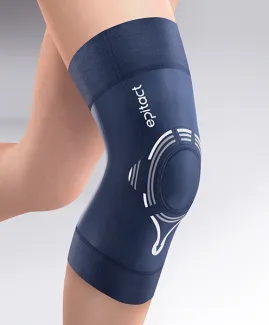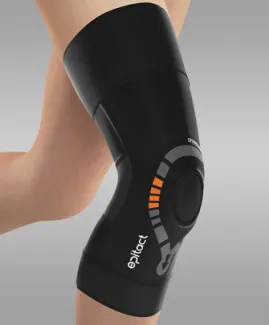
PFPS or patellofemoral pain syndrome causes intense pain in front of the knee. It is common in people doing sports, especially runners. It corresponds to a conflict between the thigh bone (femur) and the kneecap (patella), which does not slide properly in the groove during knee flexion. This multifactorial and intergenerational disease is one of the main causes of anterior knee pain(1).
EPITACT® tells you everything about the risk factors and causes of PFPS and how to ease the pain.
Patellofemoral pain syndrome: causes that you can’t avoid
The causes of patellofemoral pain syndrome can be related to anatomy, physiology and even psychology.
Anatomical abnormalities are major causes of PFPS
- Morphological abnormalities in the lower limbs: genu valgum, postural disorders of the arch of the foot, etc.
- Anatomical problems affecting the trochlea or the patella like malformation of the trochlea or high position of the patella. It results in poor guidance of the patella in the trochlea.
- Patellar instability is another cause of patellofemoral pain syndrome: the kneecap tends to subluxate toward the external side of the knee. This can go until its complete luxation.
- Femoral and/or tibial torsion, which means the femur and/or the tibia present excessive twist inward or outward.
- Hypermobility of the patella, or excessive laxity of the knee joint, encourages luxation of the patella and causes PFPS.
- Chondromalacia is the lesion of a part of the knee joint cartilage. It appears for example when one frequently practises skiing or hiking.
Other factors
- Muscle weakness or stiffness, especially of the quadriceps and hamstrings(1) can also contribute to causing patellofemoral pain syndrome.
- Women are more prone to PFPS than men for biomechanical and anatomical reasons. Indeed, women usually have less muscle strength in the legs.
- Psychological factors also have a link with chronic patellofemoral pain syndrome(2). They include anxiety, depression and kinesiophobia, which is the fear of pain caused by moving.
Patellofemoral pain syndrome: causes that you can avoid
Other than anatomy, sports practice can also explain the onset of patellofemoral pain syndrome. Indeed, knee overuse after excessive loads on the patellofemoral joint often causes PFPS. Any activity that involves high pressure between the patella and the femur or repeated stress on the joint (especially when the knees are bent) can cause patellofemoral pain syndrome(3).
Physical or sports activities
- Activities with repeated flexion/extension movements of the knee (running, brisk walking, skiing...) stand among the major causes of patellofemoral pain syndrome.
- The type of sports: in the general population, 16 to 25% of runners have patellofemoral pain syndrome.
- The type of surface on which the activity takes place.
Movements and positions
- Repeated and prolonged sitting, squatting or kneeling position.
- Going up and down stairs(1).
Other causes of PFPS
- Shoes, especially high heels increase the stress on the patellofemoral joint.
- Previous kneecap trauma and complications of ligament or meniscus surgery.
One often doesn’t imagine there are so many risk factors and causes for patellofemoral pain syndrome. Although it seems complicated to find the exact cause of PFPS, treating it is quite simple. Note that the diagnosis and treatment of this knee condition are systematically established by a health professional.
Are there solutions to relieve patellofemoral pain syndrome?
At first, you can fight against some causes of patellofemoral pain syndrome by wearing well-fitting and adapting your activities. Also, the main options aim to support and stabilise the joint to limit pain. The treatment may include physical therapy, orthopaedic insoles and knee support braces.
The PHYSIOstrap™ MEDICAL knee support* is to wear on a daily basis. It discreetly and comfortably holds the kneecap in an adequate position.
Since patellofemoral pain syndrome mainly affects sportspersons no matter the age, EPITACT® has also developed a specific device.
The PHYSIOstrap™ SPORT knee support* is made of a more compressive fabric with larger elastic strips to hold in place over a long period of time. Both knee support braces help to continue or return to daily activities and allow for complete range of motion.
In addition to this article about the causes of PFPS, EPITACT® gives you more information about the symptoms of patellofemoral pain syndrome and its medical treatments!
*These solutions are class I medical devices that bear the CE marking under this regulation. Carefully read the instructions before use. Manufacturer: Millet Innovation. 10/2023
For more details about this general and simplified approach, here are further sources:
(1)Gaitonde DY, Ericksen A, Robbins RC. Patellofemoral Pain Syndrome. AFP. 15 Jan 2019;99(2):88‑94.
(2)Maclachlan LR, Matthews M, Hodges PW, Collins NJ, Vicenzino B. The psychological features of patellofemoral pain: a cross-sectional study. Scandinavian Journal of Pain. 25 apr 2018;18(2):26171.
(3)Saubade M, Martin R, Becker A, Gremion G. Patellofemoral pain syndrome: Understand better in order to treat better. Rev Med Suisse. 2014; 10(437):1451‑6.
Boling M, Padua D, Marshall S, Guskiewicz K, Pyne S, Beutler A. Gender differences in the incidence and prevalence of patellofemoral pain syndrome: Epidemiology of patellofemoral pain. Scandinavian Journal of Medicine & Science in Sports. oct 2010;20(5):725‑30.
Payne K, Payne J, Larkin TA. Patellofemoral Pain Syndrome and Pain Severity Is Associated With Asymmetry of Gluteus Medius Muscle Activation Measured Via Ultrasound. Am J Phys Med Rehabil. juill 2020;99(7):595‑601.
 Pharmacie
Pharmacie
